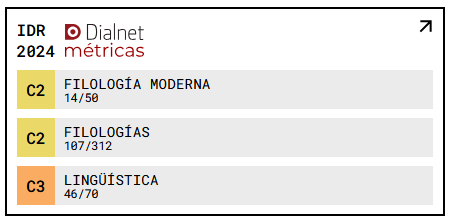Structure and design of the British Law Report Corpus (BLRC) : a legal corpus of judicial decisions from the UK
DOI:
https://doi.org/10.18172/jes.184Keywords:
Corpus linguistics, law reports, ESP, representativeness, common lawAbstract
The aim of this paper is to describe and justify the structure and design criteria to create a legal English corpus of judicial decisions. The authors, lecturers of this ESP variety, decided to engage into specific corpus design due to the small variety of teaching materials and corpora available. Judicial decisions are essential wheels in the legal machinery of common law systems and, precisely because of that fact, they are fundamental as a legal genre. This is why we intend to compile a 6m word legal corpus of UK judicial decisions in order to establish the core vocabulary of the genre and use it for further linguistic analysis and the elaboration of didactic materials.Downloads
References
Alcaraz Varó, E. 1994. El inglés jurídico: textos y documentos. Madrid: Ariel Derecho.
Bhatia, V. 1993. Analysing Genre: Language Use in Professional Settings. London: Longman.
Bhatia, V. 2004. “Applied genre analysis: a multi-perspective model”. Ibérica 4: 3-19.
Biber, D. 1993. “Representativeness in corpus design”. Literary and Linguistic Computing 8 (4): 243-257.
Bononia Legal Corpus. <http://corpora.dslo.unibo.it/bolc_eng.html> (Accessed 20 May 2010)
Constitutional Reform Act. 2005. <http://www.legislation.gov.uk/ukpga/2005/4/> (Accessed 20 May 2010)
The CorTec corpus. <http://www.fflch.usp.br/dlm/comet/consulta_cortec.html> (Accessed 20 May 2010)
Coxhead, A. 2000. “A New Academic Word List”. TESOL Quarterly 34 (2): 213-238.
Crystal, D. and D. Davy. 1969. Investigating English Style. London: Longman.
Danet, B. 1980. “Language in the Legal Process”. Law and Society Review 14, (3): 445-564.
The HOLJ corpus. <http://www.ltg.ed.ac.uk/SUM/CORPUS/index.html> (Accessed 20 May 2010)
Hunston, Susan. 2002. Corpora in applied linguistics. Cambridge: Cambridge University Press.
Hyland, K. and P. Tse. 2007. “Is there an “Academic Vocabulary”?” TESOL Quarterly, 41 (2): 235-253.
Jackson, B. 1985. Semiotics and Legal Theory. London: RKP.
JRC-Acquis corpus. <http://langtech.jrc.ec.europa.eu/JRC-Acquis.html> (Accessed 20 May 2010)
Kennedy, G. 1998. An introduction to corpus linguistics. New York: Longman.
Kennedy, G. and R. Bolitho. 1984. English for specific purposes. London: Mcmillan.
Kurzon, D. 1984. “Themes, Hyperthemes and the Discourse Structure of English Legal Texts.” Text 4: 1-3.
Maley, Y. 1987. “The Language of Legislation”. Language and Society 16: 25-48.
Maley, Y. 1994. “The Language of the Law”. Language and the Law. Ed. J.Gibbons. London: Longman.
Mellinkoff, D. 1963. The Language of the Law. Boston: Little, Brown & Co.
McEnery, T. and A. Wilson. 1996. Corpus Linguistics. Edinburgh: EUP.
Nation, I.S.P. 1990. Teaching and Learning Vocabulary. Newbury House, New York.
Nation, I.S.P. 2001. Learning vocabulary in another language. Cambridge: CUP.
Orts Llopis, M. A. 2006. Aproximación al discurso jurídico en inglés: las pólizas de seguro marítimo de Lloyd's. Madrid: Edisofer.
Orts Llopis, M. A. 2009. “Legal genres in English and Spanish: some attempts of analysis”. Ibérica 18: 109-130.
Pearson, J. 1998. Terms in Context. Amsterdam: John Benjamins.
Räisänen, C. and I. Fortanet, eds. 2008. ESP in European Higher Education: Integrating language and content. Amsterdam: John Benjamins.
Rea, C. 2008. El inglés de las telecomunicaciones: estudio léxico basado en un corpus específico. Tesis doctoral. <http://www.tesisenred.net/TDR-0611109-134048/index_cs.html> (Accessed 20 May 2010)
Rea, C. 2010. “Getting on with Corpus Compilation: from Theory to Practice”. ESP World. <http://www.esp-world.info/Articles_27/Camino%20Rea.pdf> (Accessed 20 May 2010)
Read, J. 2007. “Second Language Vocabulary Assessment: Current Practices and New Directions”. International Journal of English Studies 7 (2): 105-125.
Rossini, R., F. Tamburini, and E. Martelli. 2001. “Words from the Bononia Legal Corpus”. International Journal of Corpus Linguistics 6 (special issue): 13-34.
Sánchez, A., P. Cantos, R. Sarmiento and J. Simón. 1995. Cumbre. Corpus lingüístico del español contemporáneo. Fundamentos, metodología y análisis. Madrid: SGEL.
Sinclair, J. 1991. Corpus, Concordance and Collocation. Oxford: OUP.
Sinclair, J. 2005. “Corpus and Text - Basic Principles”. Developing Linguistic Corpora: a Guide to Good Practice. Ed. Wynne. Oxford. 1-16. <http://ahds.ac.uk/linguistic-corpora/> (Accessed 20 May 2010).
Swales, J. 1985. Episodes in ESP. Hemel: Prentice Hall.
Thorndike, E. L. and I. Lorge. 1944. The teacher's Word Book of 30,000 Words. New York: Teachers College, Columbia University.
Tiersma, P. 1999. Legal Language. Chicago: UCP.
Tognini-Bonelli, E. 2001. Corpus linguistics at work. Amsterdam & Philadelphia: John Benjamins.
Tribunals, Courts and Enforcement Act. 2007. <http://www.legislation.gov.uk/ukpga/2007/15/contents> (Accessed 20 May 2010)
West, M. 1953. A General Service List of English Words. London: Longman.
Wynne, M., ed. 2005. Developing Linguistic Corpora: a Guide to Good Practice. Oxford: ASDS Literature, Languages and Linguistics.
Downloads
Published
How to Cite
Issue
Section
License
The authors retain copyright of articles and authorize Journal of English Studies the first publication. They are free to share, redistribute, and/or reprint the article without obtaining permission from the publisher as long as they give appropriate credit to the editor and the journal.
Self-archiving is allowed too. In fact, it is recommendable to deposit a PDF version of the paper in academic and/or institutional repositories.
It is recommended to include the DOI number.
This journal is licensed under a Creative Commons Attribution 4.0 International License














